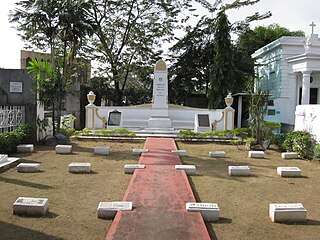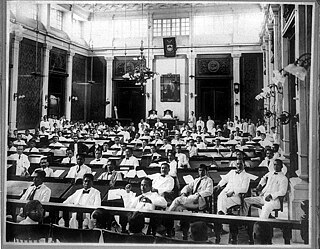
The Philippine–American War, known alternatively as the Philippine Insurrection, Filipino–American War, or Tagalog Insurgency, emerged following the conclusion of the Spanish–American War in December 1898 when the United States annexed the Philippine Islands under the Treaty of Paris. Philippine nationalists constituted the First Philippine Republic in January 1899, seven months after signing the Philippine Declaration of Independence. The United States did not recognize either event as legitimate, and tensions escalated until fighting commenced on February 4, 1899 in the Battle of Manila.

The Treaty of Peace between the United States of America and the Kingdom of Spain, commonly known as the Treaty of Paris of 1898, was signed by Spain and the United States on December 10, 1898, that ended the Spanish–American War. Under it, Spain relinquished all claim of sovereignty over and title to territories described there as the island of Porto Rico and other islands now under Spanish sovereignty in the West Indies, and the island of Guam in the Marianas or Ladrones, the archipelago known as the Philippine Islands, and comprehending the islands lying within the following line:, to the United States. The cession of the Philippines involved a compensation of $20 million from the United States to Spain.
The governor-general of the Philippines was the title of the government executive during the colonial period of the Philippines, first by the Spanish in Mexico City and later Madrid as "Captain General"– Spanish: Capitán General de Filipinas, Filipino: Kapitan Heneral ng Pilipinas) from 1565–1898 and the United States (1898–1946), and briefly by Great Britain (1762–1764) and Japan (1942–1945). They were also the representative of the executive of the ruling power.

The Philippine Revolution was a war of independence waged by the revolutionary organization Katipunan against the Spanish Empire from 1896 to 1898. It was the culmination of the 333-year colonial rule of Spain in the archipelago. The Philippines was one of the last major colonies of the Spanish Empire, which had already suffered a massive decline in the 1820s. Cuba rebelled in 1895, and in 1898, the United States intervened and the Spanish soon capitulated. In June, Philippine revolutionaries declared independence. However, it was not recognized by Spain, which sold the islands to the United States in the Treaty of Paris.
The Philippine–American War, also known as the Philippine War of Independence or the Philippine Insurrection (1899–1902), was an armed conflict between Filipino revolutionaries and the government of the United States which arose from the struggle of the First Philippine Republic to gain independence following the Philippines being acquired by the United States from Spain. This article lists significant events from before, during, and after that war, with links to other articles containing more detail.

The Thomasites were a group of 600 American teachers who traveled from the United States to the newly occupied territory of the Philippines on the US Army Transport Thomas. The group included 346 men and 180 women, hailing from 43 different states and 193 colleges, universities, and normal schools. The term 'Thomasites' has since expanded to include any teacher who arrived in the first few years of the American colonial period of the Philippines.

The Philippine Republic, now officially remembered as the First Philippine Republic and also referred to by historians as the Malolos Republic, was an insurgency established in Malolos, Bulacan during the Philippine Revolution against the Spanish Empire (1896–1898) and the Spanish–American War between Spain and the United States (1898) through the promulgation of the Malolos Constitution on January 23, 1899, succeeding the Revolutionary Government of the Philippines. It was formally established with Emilio Aguinaldo as president. It was unrecognized outside of the Philippines but remained active until April 19, 1901. Following the American victory at the Battle of Manila Bay, Aguinaldo returned to the Philippines, issued the Philippine Declaration of Independence on June 12, 1898, and proclaimed successive revolutionary Philippine governments on June 18 and 23 of that year.

The history of the Philippines from 1898 to 1946 is known as the American colonial period, and began with the outbreak of the Spanish–American War in April 1898, when the Philippines was still a colony of the Spanish East Indies, and concluded when the United States formally recognized the independence of the Republic of the Philippines on July 4, 1946.
The Philippine Commission was the name of two bodies, both appointed by the president of the United States, to assist with governing the Philippines.

The Philippine Legislature was the legislature of the Philippines from 1907 to 1935, during the American colonial period, and predecessor of the current Congress of the Philippines. It was bicameral and the legislative branch of the Insular Government.
During the United States colonial period of the Philippines (1898–1946), the United States government was in charge of providing education in the Philippines.

The Schurman Commission, also known as the First Philippine Commission, was established by United States President William McKinley on January 20, 1899, and tasked to study the situation in the Philippines and make recommendations on how the U.S. should proceed after the sovereignty of the Philippines was ceded to the U.S. by Spain on December 10, 1898, following the Treaty of Paris of 1898.

The Treaty of Manila of 1946, formally the Treaty of General Relations and Protocol, is a treaty of general relations signed on July 4, 1946, in Manila, the capital of the Philippines. It relinquished U.S. sovereignty over the Philippines and recognized the independence of the Republic of the Philippines. The treaty was signed by High Commissioner Paul V. McNutt as representative of the United States and President Manuel Roxas as representative of the Philippines.

The Political Constitution of 1899, informally known as the Malolos Constitution, was the constitution of the First Philippine Republic. It was written by Felipe Calderón y Roca and Felipe Buencamino as an alternative to a pair of proposals to the Malolos Congress by Apolinario Mabini and Pedro Paterno. After a lengthy debate in the latter part of 1898, it was promulgated on January 21, 1899.

The Philippine Organic Act that was enacted by the United States Congress on July 1, 1902 was the basic law for the Insular Government. It is also known as the Philippine Bill of 1902 and the Cooper Act, after its author Henry A. Cooper.
The sovereignty of the Philippines refers to the status of the Philippines as an independent nation. This article covers sovereignty transitions relating to the Philippines, with particular emphasis on the passing of sovereignty from Spain to the United States in the Treaty of Paris (1898), signed on December 10, 1898, to end the Spanish–American War. On December 21, 1898, US President William McKinley issued his Benevolent Assimilation Proclamation stating that future control, disposition, and government of the Philippine islands had been ceded to the United States and that the US military government was to be extended over the whole of the ceded territory. However, as ratification of the treaty ceding sovereignty to the US was still pendino. In March 1897, Emilio Aguinaldo, a member of the Katipunan, was elected as president of a revolutionary government established after the Tejeros Convention. That government was supposedly meant to replace the Katipunan, though the latter was not formally abolished until 1899. Aguinaldo was again elected as president at Biak-na-Bato in November 1897, leading the Biak-na-Bato Republic. Exiled in Hong Kong after the Pact of Biak-na-Bato, he returned to the Philippines to renew revolutionary activities with the advent of the Spanish–American War and, in May 1898, formed a dictatorial government. On June 12, 1898, Aguinaldo's nascent government proclaimed independence from Spain. This proclamation, however, did not dissolve Spanish sovereignty over the Philippines, which continued despite this declaration. Sovereignty passed from Spain to the United States in the 1898 Treaty of Paris.

The Insular Government of the Philippine Islands was an unincorporated territory of the United States that was established on April 11, 1899 upon ratification of the 1898 Treaty of Paris. It was reorganized in 1935 in preparation for later independence. The Insular Government was preceded by the Military Government of the Philippine Islands and was followed by the Commonwealth of the Philippines.

Pedro Tongio Liongson was a member of the Malolos Congress which wrote the constitution of the First Philippine Republic in 1899 and served as First Director of Military Justice in the Republic's army during the Philippine–American War of 1899–1901. A trained lawyer and judge, Col. Liongson figured in and left his mark on a number of historic events in the Philippines.

The Military Government of the Philippine Islands was a military government in the Philippines established by the United States on August 14, 1898, a day after the capture of Manila, with General Wesley Merritt acting as military governor. General Merrit established this military government by proclamation on August 14, 1898.
1901 in the Philippines details events of note that happened in the Philippines in 1901

















